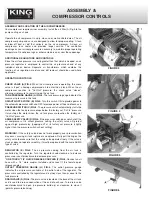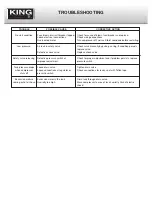
ASSEMBLY AND LOCATION OF THE AIR COMPRESSOR
Your compressor requires minor assembly. Install the air filter (A) Fig.3 to the
pump casting as shown.
Operate the air compressor in a dry, clean, cool, well ventilated area. The air
compressor pump and case are designed to allow for proper cooling. Clean
or blow off dust or dirt that collects on the air compressor. A clean air
compressor runs cooler and provides longer service. The ventilation
openings on your air compressor are necessary to maintain proper operating
temperature. Do not place rags or other containers on or near these openings.
ADDITIONAL REGULATORS AND CONTROLS
Since the air tank pressure is usually greater than that which is needed, an air
pressure regulator is employed to control the air pressure ahead of any
individual driven device. Seperate air transformers which combine the
function of air regulation, moisture and dirt removal should be used where
applicable.
OPERATION CONTROLS
CHECK VALVE (A) FIG.4.
When the air compressor is operating, the check
valve is “open”, allowing compressed air to enter the air tank. When the air
compressor reaches its “Cut-Out” pressure, the check valve “closes”,
allowing air pressure to remain inside the air tank.
TANK PRESSURE GAUGE (A) FIG.5.
The tank pressure gauge indicates the
reserve air pressure in the tank.
ON/AUTO-OFF SWITCH (B) FIG.5.
Turn this switch ON to provide power to
the automatic pressure switch and OFF to remove power at the end of each use.
PRESSURE SWITCH (C) FIG.5.
The pressure switch automatically starts the
motor when the tank pressure drops below the factory set “Cut-In” pressure.
It also stops the motor when the air tank pressure reaches the factory set
“Cut-Out” pressure.
ASME SAFETY VALVE (D) FIG.5.
If the pressure switch does not shut off the
air compressor at its cutout pressure setting, the safety valve will protect
against high pressure by “popping out” at its factory set pressure (slightly
higher than the pressure switch cut-out setting).
WARNING!
: If the safety valve does not work properly, over pressurization
may occur, causing air tank rupture or an explosion. Daily pull the ring on the
safety valve to make sure that the safety valve operates freely. If the valve is
stuck or does not operate smoothly, it must be replaced with the same ASME
type of valve.
REGULATOR (E) FIG.5.
The air pressure coming from the air tank is
controlled by the regulator. Turn the regulator knob clockwise to increase
pressure or counterclockwise to decrease pressure.
“ONE TOUCH” 1/4” QUICK RELEASE COUPLER (F) FIG.5.
Connect an air
hose with a 1/4” male coupler installed and connect it this female quick
release coupler.
OUTLET PRESSURE GAUGE (G) FIG.5.
The outlet pressure gauge
indicates the air pressure available at the outlet side of the regulator. The
pressure is controlled by the regulator and is always less than or equal to the
tank pressure.
DRAIN VALVE (A) FIG.6.
The drain valve is located at the base of the air tank
and is used to drain condensation at the end of each use. Turn drain valve
counterclockwise to open (no pressure build-up) or clockwise to close it
(permits pressure build-up).
FIGURE 3
FIGURE 4
FIGURE 5
FIGURE 6
ASSEMBLY &
COMPRESSOR CONTROLS

























